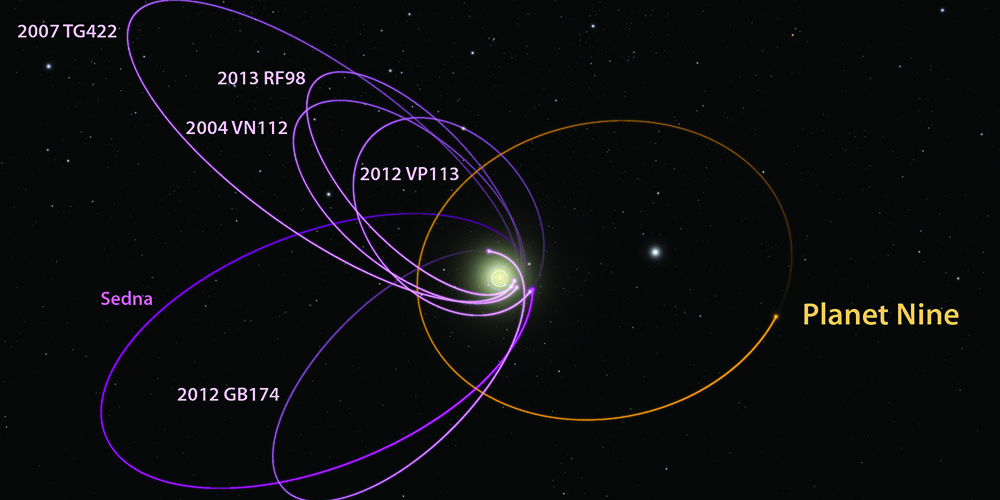An Old Theory on Mass Extinctions
Gets a Second Life
The fossil record is like a history book of the Earth, and in the 1980s two paleontologists who knew how to read it came across something odd: Every 27 million years or so, species die off en masse.
Extinctions happen throughout geologic time. But millions of species going extinct on a predictable schedule points to something big. “We favor extraterrestrial causes,” University of Chicago paleontologists David Raup and Jack Sepkoski wrote in a 1983 paper.
Their idea was that every 27 million years or so, comets rain down on Earth for centuries, raising dust clouds that block out the sun. Temperatures dive as the skies darken. Plants that depend on sunlight for photosynthesis die. Animals that depend on the plants die, and up the chain it goes.
But if comets explain mass extinctions, what explains the comets?

Whitmire, pictured, and his colleague John Matese first published their Planet X theory in 1984
In 1985, University of Louisiana at Lafayette astrophysicists Daniel Whitmire and John Matese devised a possible answer: Planet X, an undiscovered celestial body orbiting the farthest reaches of the solar system, beyond Pluto. As it circles the sun, its tilted orbit slowly rotates, causing it to pass through the Kuiper belt of comets, knocking some into the inner solar system where they rain down on Earth and probably other planets. By their calculations, Planet X should be one to five times the mass of the Earth, and about 100 times more distant from the sun.
Whitmire and Matese didn’t invent the Planet X theory; astronomers have been looking for a planet beyond Neptune for 100 years. Whitmire and Matese’s contribution was tying the elusive planet to mass extinctions. Much has happened in the 30-plus years since they published their theory in the journal Nature; both men retired from Louisiana-Lafayette, Whitmire now teaches in the mathematics department at the University of Arkansas.
Recently, their theory has taken a step toward plausibility with new research by astronomers at the California Institute of Technology, or Caltech. “They are saying there’s a 90 percent chance there is something out there,” Whitmire said. “For me, that’s very positive because in the past no one was excited about this.”
Solar System Census
Ancient Greeks knew of seven “wanderers,” including the five visible to the naked eye – Mercury, Venus, Mars, Jupiter and Saturn – plus the moon and the sun, which fit the ancient definition. (“Planets” is Greek for “wanderer,” meaning celestial objects that move relative to the fixed stars.) Earth joined the party in the 16th century when Copernicus postulated that it circled the sun.
That brought the count to six: the five visible planets plus Earth. (The moon and the sun were demoted by Copernicus.) In 1781, amateur astronomer William Herschel found Uranus, planet No. 7. Frenchman Urbain Le Verrier discovered Neptune, the eighth planet, in 1846. Pluto came along in 1930, discovered by American astronomer and erstwhile Kansas farm boy Clyde Tombaugh.
Thus the solar system remained until 2006, when astronomers demoted Pluto to the status of dwarf planet, one of millions of icy objects that make up the Kuiper belt beyond Neptune.
In 2003, Caltech astronomer Mike Brown found Sedna, an icy world slightly smaller than Pluto, whose perihelion, or closest point to the sun, was beyond the Kuiper belt. Its strange, tilted orbit suggested gravitational influence. Subsequent discoveries of similar objects implied that something was tugging on the little ice worlds, causing their orbits to cluster.
Brown and colleague Konstantin Batygin published research in 2016 stating that the possibility of that happening by chance was just .007 percent. They concluded that Planet X is doing the tugging. “[Brown is] a very conservative scientist,” said Whitmire. “This prediction has been made by a couple people in the past four years, but [Brown and Batygin] did a better and more detailed analysis.”
An Old Theory is New Again
Whitmire and Matese’s original 1984 paper was featured prominently in a 1985 Time magazine cover story titled “Did Comets Kill the Dinosaurs? A Bold New Theory About Mass Extinctions,” and reported in several scientific journals.
Interest in the theory waned, however, because of a relatively high probability that the extinction intervals did not occur as regularly as first thought. Without those intervals, the theory was a blind alley. “The stats weren’t that great,” Whitmire said, “so it got put on the back burner. And that’s where it stayed until a couple years ago.”
That’s when paleontologists, using refined geologic data, were able to show that the extinction intervals held fast for twice as far back in time as originally thought, and were also more regular than previously believed. Suddenly, scientists were very interested in Planet X again. No wonder. If the evolutionary clock is essentially reset every 27 million years, the implications for our understanding of life on earth are profound.
In January 2016, Whitmire, working without the retired Matese, published a freshened version of their work in the journal Monthly Notices of the Royal Astronomical Society. The improved geological data, along with Brown and Batygin’s evidence of Planet X, brought his own work back from the brink of extinction.

The six most distant known objects in the solar system with orbits exclusively beyond Neptune, whose orbits are shown in magenta, all mysteriously line up in a single direction. Moreover, when viewed in three dimensions, they are all tilted nearly identically away from the plane of the solar system. Such an orbital alignment can only be maintained by some outside force. (Diagram by R. Hurt/ Caltech-IPAC)
Brown and Batygin’s prediction of Planet X is not exactly the same as Whitmire and Matese’s prediction. The former is more massive and distant from the sun than the latter. And if Brown and Batygin are correct, Whitmire’s numbers don’t work. But both teams could be predicting the same planet, because a smaller, closer planet can have the same or greater gravitational effect than a larger, more distant one. “Even if they found exactly what they are talking about, it still doesn’t rule ours out,” Whitmire said. “There could be another one there, in fact the discovery of any one planet increases the probability of two or more.”
In fact, in a study published in the September 2016 issue of The Astronomical Journal, Harvard astrophysicists Matthew Holman and Matthew Payne bolstered the case for Planet X and added credence to the idea of two unknown planets.
In any case, finding Planet X is what’s really exciting for Whitmire, who at 73 has been fascinated with exploring the universe since he was 10 years old.
“I’ve been part of this story for 30 years,” he said. “If there ever is a final answer I’d love to write a book about it.”



